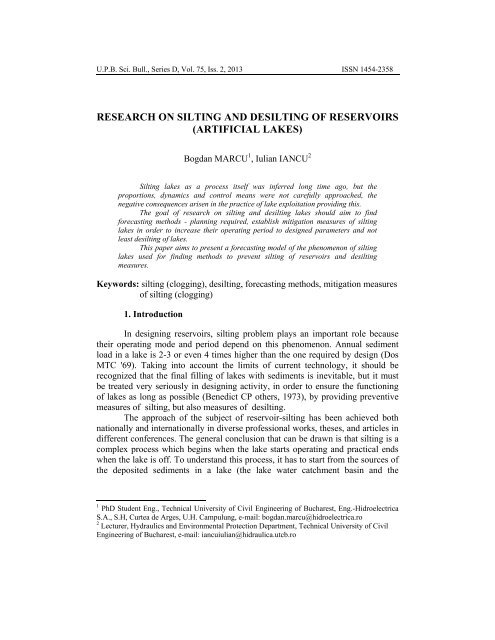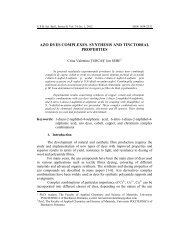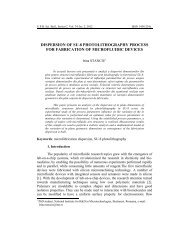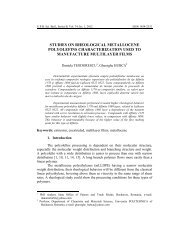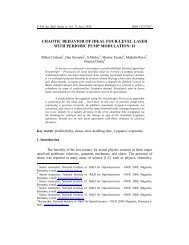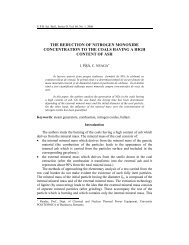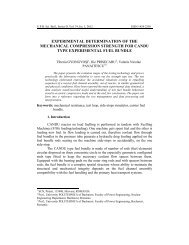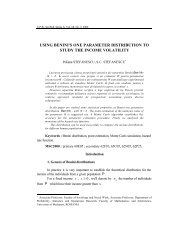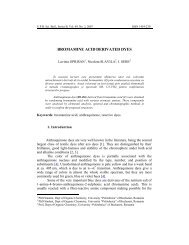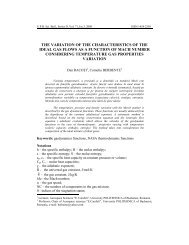research on silting and desilting of reservoirs - Scientific Bulletin
research on silting and desilting of reservoirs - Scientific Bulletin
research on silting and desilting of reservoirs - Scientific Bulletin
You also want an ePaper? Increase the reach of your titles
YUMPU automatically turns print PDFs into web optimized ePapers that Google loves.
U.P.B. Sci. Bull., Series D, Vol. 75, Iss. 2, 2013 ISSN 1454-2358<br />
RESEARCH ON SILTING AND DESILTING OF RESERVOIRS<br />
(ARTIFICIAL LAKES)<br />
Bogdan MARCU 1 , Iulian IANCU 2<br />
Silting lakes as a process itself was inferred l<strong>on</strong>g time ago, but the<br />
proporti<strong>on</strong>s, dynamics <strong>and</strong> c<strong>on</strong>trol means were not carefully approached, the<br />
negative c<strong>on</strong>sequences arisen in the practice <strong>of</strong> lake exploitati<strong>on</strong> providing this.<br />
The goal <strong>of</strong> <str<strong>on</strong>g>research</str<strong>on</strong>g> <strong>on</strong> <strong>silting</strong> <strong>and</strong> de<strong>silting</strong> lakes should aim to find<br />
forecasting methods - planning required, establish mitigati<strong>on</strong> measures <strong>of</strong> <strong>silting</strong><br />
lakes in order to increase their operating period to designed parameters <strong>and</strong> not<br />
least de<strong>silting</strong> <strong>of</strong> lakes.<br />
This paper aims to present a forecasting model <strong>of</strong> the phenomen<strong>on</strong> <strong>of</strong> <strong>silting</strong><br />
lakes used for finding methods to prevent <strong>silting</strong> <strong>of</strong> <strong>reservoirs</strong> <strong>and</strong> de<strong>silting</strong><br />
measures.<br />
Keywords: <strong>silting</strong> (clogging), de<strong>silting</strong>, forecasting methods, mitigati<strong>on</strong> measures<br />
<strong>of</strong> <strong>silting</strong> (clogging)<br />
1. Introducti<strong>on</strong><br />
In designing <strong>reservoirs</strong>, <strong>silting</strong> problem plays an important role because<br />
their operating mode <strong>and</strong> period depend <strong>on</strong> this phenomen<strong>on</strong>. Annual sediment<br />
load in a lake is 2-3 or even 4 times higher than the <strong>on</strong>e required by design (Dos<br />
MTC '69). Taking into account the limits <strong>of</strong> current technology, it should be<br />
recognized that the final filling <strong>of</strong> lakes with sediments is inevitable, but it must<br />
be treated very seriously in designing activity, in order to ensure the functi<strong>on</strong>ing<br />
<strong>of</strong> lakes as l<strong>on</strong>g as possible (Benedict CP others, 1973), by providing preventive<br />
measures <strong>of</strong> <strong>silting</strong>, but also measures <strong>of</strong> de<strong>silting</strong>.<br />
The approach <strong>of</strong> the subject <strong>of</strong> reservoir-<strong>silting</strong> has been achieved both<br />
nati<strong>on</strong>ally <strong>and</strong> internati<strong>on</strong>ally in diverse pr<strong>of</strong>essi<strong>on</strong>al works, theses, <strong>and</strong> articles in<br />
different c<strong>on</strong>ferences. The general c<strong>on</strong>clusi<strong>on</strong> that can be drawn is that <strong>silting</strong> is a<br />
complex process which begins when the lake starts operating <strong>and</strong> practical ends<br />
when the lake is <strong>of</strong>f. To underst<strong>and</strong> this process, it has to start from the sources <strong>of</strong><br />
the deposited sediments in a lake (the lake water catchment basin <strong>and</strong> the<br />
1 PhD Student Eng., Technical University <strong>of</strong> Civil Engineering <strong>of</strong> Bucharest, Eng.-Hidroelectrica<br />
S.A., S.H, Curtea de Arges, U.H. Campulung, e-mail: bogdan.marcu@hidroelectrica.ro<br />
2 Lecturer, Hydraulics <strong>and</strong> Envir<strong>on</strong>mental Protecti<strong>on</strong> Department, Technical University <strong>of</strong> Civil<br />
Engineering <strong>of</strong> Bucharest, e-mail: iancuiulian@hidraulica.utcb.ro
188 Bogdan Marcu, Iulian Iancu<br />
hydrographic network) <strong>and</strong> it must take into account the two forms <strong>of</strong> solid<br />
c<strong>on</strong>tributi<strong>on</strong>, namely: the dragged solid flow <strong>and</strong> the suspended solid flow.<br />
Because clogging <strong>of</strong> artificial lakes reduces their capacity, <strong>and</strong> hence their<br />
operating period, studies <strong>and</strong> appropriate measures are needed to reduce the<br />
intensity <strong>of</strong> this process. In our country these studies must be a current problem,<br />
imposed by the large number <strong>of</strong> lakes affected by this phenomen<strong>on</strong>.<br />
Clogging lakes must be a permanent c<strong>on</strong>cern <strong>of</strong> the specialized groups in<br />
the field <strong>of</strong> water management, river basin planning complex, envir<strong>on</strong>ment<br />
protecti<strong>on</strong> etc.<br />
The goal <strong>of</strong> <str<strong>on</strong>g>research</str<strong>on</strong>g> <strong>on</strong> <strong>silting</strong> <strong>and</strong> de<strong>silting</strong> <strong>of</strong> <strong>reservoirs</strong> (artificial lakes)<br />
should aim to find forecasting methods-planning required (to calculate the<br />
capacity reserved for sediments in a lake from its opening till the end <strong>of</strong> its<br />
working period), to establish mitigati<strong>on</strong> measures <strong>of</strong> <strong>silting</strong> lakes to increase their<br />
working period to the designed parameters <strong>and</strong> not least de<strong>silting</strong> lakes, which is<br />
very expensive[1].<br />
Another problem frequently approached in studies is the quantitative<br />
evaluati<strong>on</strong> <strong>of</strong> damage due to clogging, which is extremely difficult. In the<br />
specialized literature there are still some global data, which give an idea <strong>of</strong> the<br />
order <strong>of</strong> magnitude <strong>of</strong> such damage. The informati<strong>on</strong> related to the specific costs<br />
<strong>of</strong> <strong>reservoirs</strong> achievement is very interesting <strong>on</strong> the course <strong>of</strong> time. It can be<br />
noticed a gradual increase <strong>of</strong> their amount in time. This is due to general increase<br />
in prices, but also because the appropriate sites for <strong>reservoirs</strong> were partially<br />
depleted. So, all existing <strong>reservoirs</strong> should be protected by a series <strong>of</strong> measures.<br />
This paper aims for a particular case <strong>of</strong> a lake, to present a forecasting<br />
model <strong>of</strong> the phenomen<strong>on</strong> <strong>of</strong> <strong>silting</strong> lakes, model which can be used later for<br />
finding methods <strong>and</strong> measures to prevent reservoir-<strong>silting</strong> <strong>and</strong> also de<strong>silting</strong><br />
measures.<br />
2. Zig<strong>on</strong>eni lake (accumulati<strong>on</strong>)<br />
Zig<strong>on</strong>eni lake, the fourth lake situated downstream <strong>of</strong> Vidraru lake, is<br />
located <strong>on</strong> the Arges River approx. 3.5 km downstream <strong>of</strong> the c<strong>on</strong>fluence with the<br />
Valley Sasu brook, village Zig<strong>on</strong>eni, commune Baiculesti[2].<br />
Zig<strong>on</strong>eni lake (accumulati<strong>on</strong>) has as main functi<strong>on</strong> producing electricity<br />
(15.40 MW installed capacity, installed flow 90 m 3 /s).<br />
The fr<strong>on</strong>tal dam c<strong>on</strong>sists <strong>of</strong> an outlet structure type spillway, multiple<br />
stage, with a flap, segment valves <strong>and</strong> a buffer <strong>of</strong> retenti<strong>on</strong> which is provided with<br />
two lateral dams for fixing <strong>on</strong> the shores. The dam is made from a massive<br />
c<strong>on</strong>crete invert in which there are inserted right shore abutment, left shore<br />
abutment <strong>and</strong> two intermediate cells with a width <strong>of</strong> 2.0 m. The dam headroom is
Research <strong>on</strong> <strong>silting</strong> <strong>and</strong> de<strong>silting</strong> <strong>of</strong> <strong>reservoirs</strong> (artificial lakes) 189<br />
27.00 m <strong>and</strong> the length <strong>of</strong> the spillway dam is 20.60 m (photo 1). The crest <strong>of</strong> a<br />
wave level is 395.00 mdM <strong>and</strong> the foundati<strong>on</strong> level is 366.30 mdM.<br />
Photo. 1. Zig<strong>on</strong>eni – The fr<strong>on</strong>tal dam.<br />
Photo. 2. Zig<strong>on</strong>eni lake (accumulati<strong>on</strong>).<br />
The dam has a flap 16.00 x 3.00 m with a hinge at level 389.80mdM <strong>and</strong> 3<br />
segment valves 4.00 x 4.00 m with weir still at level 377.50 mdM <strong>and</strong> a lateral<br />
outlet structure (2 secti<strong>on</strong> galleries 2.50 x 2.00 m, located <strong>on</strong> the left shore <strong>of</strong> the<br />
dam).<br />
The maximum calculati<strong>on</strong> flow with an exceeding probability <strong>of</strong> 1%, is<br />
Q1% = 470.00 m 3 /s <strong>and</strong> the maximum test flow, with an exceeding probability <strong>of</strong><br />
1 ‰ is ‰ Q1 = 840.00 m 3 /s.<br />
The lake has a total volume <strong>of</strong> 13,300 milli<strong>on</strong> cubic meters (photo 2). The<br />
normal top-water level is at 393.00 mdM, <strong>and</strong> the lowest operating level is at<br />
384.60 mdM. The lake has a total surface <strong>of</strong> 182 ha NNR, a length <strong>of</strong> 3.10 km <strong>and</strong><br />
a width <strong>of</strong> 0.70 km.<br />
Photo. 3. Zig<strong>on</strong>eni lake (accumulati<strong>on</strong>).<br />
Photo. 4. The tail <strong>of</strong> Zig<strong>on</strong>eni lake.
190 Bogdan Marcu, Iulian Iancu<br />
3. The clogged volume determinati<strong>on</strong><br />
The clogged volume determinati<strong>on</strong> for Zig<strong>on</strong>eni Lake is based <strong>on</strong> topobathymetric<br />
measurements. These measurements are performed every two years.<br />
The measuring techniques <strong>of</strong> water depth can be classified into: techniques<br />
using mechanical measuring equipment <strong>and</strong> techniques using electr<strong>on</strong>ic<br />
measuring equipment.<br />
The depth measurement techniques using mechanical equipment provide<br />
data with a very good precisi<strong>on</strong> when measuring small depths, about 10 – 15 m.<br />
Above these depth values the accuracy decrease significantly. Accuracy is very<br />
good for areas in which the water bottom c<strong>on</strong>sists <strong>of</strong> hard sediments, so that the<br />
used water gauges do not penetrate deeply these sediments. Accuracy is str<strong>on</strong>gly<br />
affected if the compositi<strong>on</strong> <strong>of</strong> deposited sediments <strong>on</strong> the bottom is low, test<br />
probes could penetrate them <strong>on</strong> distances which can vary from few centimeters to<br />
2.1 meters, thus altering the real value <strong>of</strong> the measurement. The measurement<br />
methods which apply the depth measurement techniques using mechanical<br />
equipment are: sounding pole <strong>and</strong> sounding disk [3].<br />
The depth measurement techniques using electr<strong>on</strong>ic equipment provide<br />
data with a very good precisi<strong>on</strong> without taking into account the size <strong>of</strong> the<br />
measured depth. Accuracy is very good no matter how the c<strong>on</strong>sistency <strong>of</strong> bottom<br />
deposited sediment is, due to the possibility <strong>of</strong> coupling with calculati<strong>on</strong><br />
electr<strong>on</strong>ic equipment which can minimize all types <strong>of</strong> errors. The measurement<br />
methods which apply the depth measurement techniques using electr<strong>on</strong>ic<br />
equipment are: acoustic sounding method (echo sounding) <strong>and</strong> image processing<br />
method provided by the sensors installed <strong>on</strong> geostati<strong>on</strong>ary satellites (mapping<br />
water depths from space).<br />
For Zig<strong>on</strong>eni lake, until 2009, depth was measured using the sounding<br />
disk method, <strong>and</strong> since 2009 it has been used the echo sounding method (s<strong>on</strong>ar).<br />
Topo-bathymetric measurements are used for the live storage determinati<strong>on</strong>. The<br />
difference between this <strong>and</strong> the initial volume represents the clogged volume (Fig.<br />
1, Table I).<br />
Table 1<br />
The clogged volume determinati<strong>on</strong>[4]<br />
Lake volume Volume differences Clogged volume<br />
Year<br />
(m 3 )<br />
(m 3 )<br />
(m 3 )<br />
1978 13,300,000.000 0.000 0<br />
1996 9,804,357.000 3,495,643.000 3,495,643.000<br />
1999 9,392,544.000 411,813.000 3,907,456.000<br />
2001 9,299,314.000 93,230.000 4,000,686.000<br />
2003 9,053,711.000 245,603.000 4,246,289.000<br />
2005 8,075,155.000 978,556.000 5,224,845.000<br />
2007 7,732,067.000 343,088.000 5,567,933.000<br />
2009 7,596,137.000 135,930.000 5,703,863.000<br />
2011 7,418,436.980 177,700.020 5,881,563.020
Research <strong>on</strong> <strong>silting</strong> <strong>and</strong> de<strong>silting</strong> <strong>of</strong> <strong>reservoirs</strong> (artificial lakes) 191<br />
Fig.1. The evoluti<strong>on</strong> <strong>of</strong> Zig<strong>on</strong>eni lake clogging.<br />
Comparatively, using bathymetric measurements, in Fig. 2 it is shown the<br />
evoluti<strong>on</strong> <strong>of</strong> clogging between 2009 <strong>and</strong> 2011 for two transversal pr<strong>of</strong>iles through<br />
the lake.<br />
4. The clogging degree forecasting<br />
The calculati<strong>on</strong> model <strong>of</strong> <strong>silting</strong> forecast (determining the volume <strong>of</strong> the<br />
transported alluvial material in the lake) was performed using HEC-RAS<br />
computer program. HEC-RAS, developed by the U.S. Army Corps <strong>of</strong> Engineers,<br />
Hydrologic Engineering Center, is <strong>on</strong>e <strong>of</strong> the most known <strong>and</strong> used packages in<br />
the world, regarding the analysis <strong>of</strong> hydrographical systems[5].<br />
Fig. 2. Pr<strong>of</strong>iles through Zig<strong>on</strong>eni lake to underline the phenomen<strong>on</strong> <strong>of</strong> clogging between 2009 <strong>and</strong><br />
2011.
192 Bogdan Marcu, Iulian Iancu<br />
The program, which applies <strong>on</strong>e-dimensi<strong>on</strong>al flow model with the free<br />
surface, can calculate this surface <strong>on</strong> permanent <strong>and</strong> n<strong>on</strong>-permanent move,<br />
gradually varied <strong>on</strong> natural rivers or built channels, <strong>and</strong> also calculate, using input<br />
data the volume <strong>of</strong> transported <strong>and</strong> deposited sediments.<br />
For the calculati<strong>on</strong> <strong>of</strong> sediment transport, the HEC-RAS must first solve<br />
the flow in that river secti<strong>on</strong>. Like other models, the HEC-RAS uses a simplified<br />
hydrodynamic model, a comm<strong>on</strong> approach used in various sediment transport<br />
models. Thus, HEC-RAS uses the quasi-permanent movement hypothesis that<br />
estimates the flow hydrograph with a series <strong>of</strong> discrete pr<strong>of</strong>iles for which the flow<br />
is c<strong>on</strong>stant. Thus, the pr<strong>of</strong>iles in which the flow is permanent are easier to deploy<br />
<strong>and</strong> their rolling is much faster.<br />
HEC-RAS for modeling sediments transport solves the Exner equati<strong>on</strong><br />
(sediment c<strong>on</strong>tinuity equati<strong>on</strong>):<br />
∂η<br />
∂Qs<br />
( 1− λp<br />
) B =−<br />
(1)<br />
∂ t ∂ x<br />
where: B – channel width, η – chanel share, λ p – bed porosity, t – time, x –distance,<br />
Q s – transported solid flow[6].<br />
Equati<strong>on</strong> (1) specifies that changing <strong>of</strong> the transported solid flow in a<br />
c<strong>on</strong>trol volume, is the difference between the entered solid flow <strong>and</strong> the <strong>on</strong>e<br />
emerged from that volume. The equati<strong>on</strong> is solved by calculating the transport<br />
capacity (<strong>of</strong> transported solid flow) through a c<strong>on</strong>trol volume associated with each<br />
cross secti<strong>on</strong> <strong>of</strong> calculati<strong>on</strong>. This transported solid flow is compared with the solid<br />
flow entering the c<strong>on</strong>trol volume. If the transported solid flow is bigger than the<br />
entered <strong>on</strong>e, then there is a lack <strong>of</strong> sediments in the c<strong>on</strong>trol volume, deficit which<br />
is replenished by the riverbed erosi<strong>on</strong>. If there is a surplus <strong>of</strong> transported solid<br />
flow, then the excess <strong>of</strong> sediment is deposited.<br />
Following the recording <strong>and</strong> reproducti<strong>on</strong> <strong>of</strong> <strong>silting</strong> phenomen<strong>on</strong> that<br />
occurs naturally in the analyzed site, the calculati<strong>on</strong> model used to perform<br />
reservoir-<strong>silting</strong> forecast is based <strong>on</strong> data regarding the annual volumes <strong>of</strong><br />
reservoir-<strong>silting</strong> <strong>and</strong> the hydrological data <strong>of</strong> accumulati<strong>on</strong> (flows, exploitati<strong>on</strong><br />
system, granulometric keys <strong>of</strong> transported alluvial material etc.).<br />
To reproduce the <strong>silting</strong> phenomen<strong>on</strong> <strong>of</strong> Zig<strong>on</strong>eni Lake, the flow model<br />
will cover the lake itself, <strong>and</strong> the tail race from CHE Noapteş, the upstream<br />
accumulati<strong>on</strong> from CHE Zig<strong>on</strong>eni. The tail race, an excavati<strong>on</strong> channel with<br />
trapezoidal secti<strong>on</strong> has a length <strong>of</strong> 2063.70 m, <strong>and</strong> a slope <strong>of</strong> 0.243‰. Besides this<br />
trail race, the natural bed <strong>of</strong> the Arges river will be modeled too.<br />
The flow modeling <strong>on</strong> the two rivers will be realized under the quasi-n<strong>on</strong>permanent<br />
movement regime, for the flow with an exceeding probability <strong>of</strong> 1%,<br />
the flow model calibrati<strong>on</strong> being based <strong>on</strong> the roughness <strong>of</strong> the two beds.
Research <strong>on</strong> <strong>silting</strong> <strong>and</strong> de<strong>silting</strong> <strong>of</strong> <strong>reservoirs</strong> (artificial lakes) 193<br />
Fig. 3. Sediment transport modeling for Zig<strong>on</strong>eni lake clogging forecasting.<br />
The sediment transport <strong>on</strong> the two rivers is realized starting from the<br />
grading curves <strong>of</strong> the transported material being in suspensi<strong>on</strong>. Regarding the<br />
transport <strong>of</strong> suspended solid particles, these are distributed throughout the mass<br />
current, their keeping in suspensi<strong>on</strong> being achieved by the effect <strong>of</strong> the turbulent<br />
velocity pulsati<strong>on</strong>s.<br />
In general, fine particles which are small comp<strong>on</strong>ents <strong>of</strong> the riverbed are<br />
carried in suspensi<strong>on</strong>. Therefore, the solid suspensi<strong>on</strong> flow depends <strong>on</strong> the<br />
available flow from the water current rather than <strong>on</strong> the transport capacity <strong>of</strong> the<br />
liquid current. In most cases this transport is unsaturated.<br />
Obtaining formulas for suspended solid flow calculati<strong>on</strong> requires<br />
knowledge <strong>of</strong> both speed <strong>and</strong> c<strong>on</strong>centrati<strong>on</strong>. Regarding the vertical distributi<strong>on</strong> <strong>of</strong><br />
c<strong>on</strong>centrati<strong>on</strong> there are menti<strong>on</strong>ed the following theories: the theory <strong>of</strong> turbulent<br />
diffusi<strong>on</strong>, the energetic theory <strong>and</strong> the gravitati<strong>on</strong>al theory[7].<br />
The sediment transport calibrati<strong>on</strong> will be based <strong>on</strong> measured data<br />
regarding the clogged volume <strong>of</strong> Zig<strong>on</strong>eni Lake. Once calibrated <strong>and</strong> validated<br />
this model can be then applied to forecast future volumes <strong>of</strong> transported sediment<br />
material which will be deposited in the lake<br />
Using this calculati<strong>on</strong> model provides (in c<strong>on</strong>diti<strong>on</strong>s <strong>of</strong> the calculati<strong>on</strong><br />
model calibrati<strong>on</strong>) the forecasting <strong>of</strong> the alluvial material quantity transported <strong>and</strong><br />
deposited in the lake.<br />
5. C<strong>on</strong>clusi<strong>on</strong>s<br />
The sediment transport modeling is a difficult process because the data<br />
used to forecast this transport <strong>and</strong> riverbed changes are extremely sensitive to a<br />
wide range <strong>of</strong> physical parameters. However, <strong>on</strong>ce calibrated, a forecasting model<br />
<strong>of</strong> sediment transport can provide <strong>on</strong> a l<strong>on</strong>g-term the regi<strong>on</strong>al trends <strong>and</strong> it can be<br />
used as a decisi<strong>on</strong> <strong>and</strong> planning tool.<br />
This model will be applied in a report <strong>of</strong> a doctoral thesis regarding the<br />
reproducti<strong>on</strong> <strong>and</strong> forecasting <strong>of</strong> the clogging phenomen<strong>on</strong> <strong>of</strong> an artificial lake.
194 Bogdan Marcu, Iulian Iancu<br />
R E F E R E N C E S<br />
[1] I. Giurma, Colmatarea lacurilor de acumulare (Silting <strong>of</strong> <strong>reservoirs</strong>), Publidher UTCB<br />
Bucureşti, 1997.<br />
[2] ***, ITI – istructiuni tehnice interne SH Curtea de Arges – CHE Zig<strong>on</strong>eni, partea de c<strong>on</strong>structii<br />
si echipament hidromecanic (Internal Technical Instructi<strong>on</strong>s SH Curtea de Arges – CHE<br />
Zig<strong>on</strong>eni, the C<strong>on</strong>structi<strong>on</strong> <strong>and</strong> Hydraulic Equipment), 2012.<br />
[3] A.G. C<strong>on</strong>stantinescu, D.C.C<strong>on</strong>stantinescu, Tehnici de măsurare a adâncimii apei (Techniques<br />
for measuring water depth), <strong>Scientific</strong> <strong>and</strong> technical bulletin <strong>of</strong> Icemenerg, Publisher<br />
Icemenerg, 2006<br />
[4] ***, Masuratori topobatimetrice efectuate de SH Curtea de Arges 1996-2001 (Topographicbathymetric<br />
measurements made by SH Curtea de Arges 1996-2011).<br />
[5] ***, HEC-RAS 4.1 User’s manual, 2010<br />
[6] ***, HEC-RAS 4.1 Hydraulic Reference Manual, 2010.<br />
[7] O. Luca, Hidraulica cursurilor de apă (Hydraulics <strong>of</strong> watercourses), Publisher C<strong>on</strong>spress, 1998.


